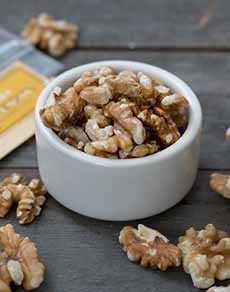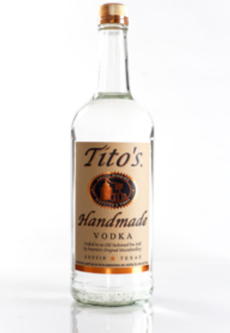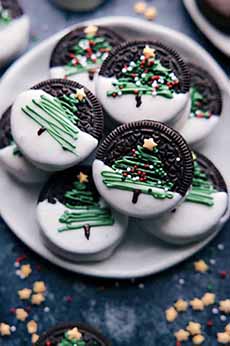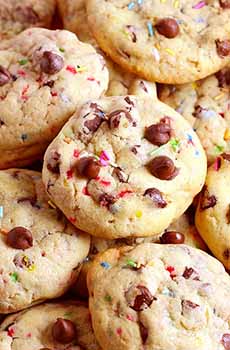|

[1] Galette des Rois from the acclaimed French pastry chef Raymond Blanc. Here’s his recipe (photo © Raymond Blanc).
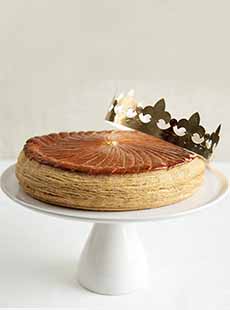
[2] Many bakeries provide a gold paper crown so the person who gets the slice with the fève (charm) can be crowned king or queen. You can buy this cake and crown from Goldbelly (photo © Goldbelly | Blogspot). You can also buy the crowns on Amazon or make your own.
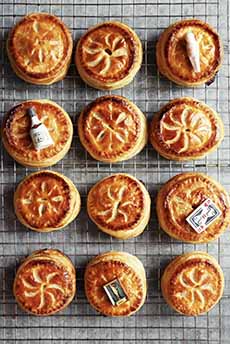
[4] Galette cookies from Joy The Baker: rough-puff pastry with pistachio-rose filling. Here’s her recipe (photo © Joy The Baker).

[5] Pierre Hermé’s galettes, some garnished with glazed apple slices (photo © Pierre Hermé).
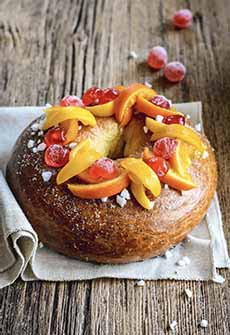
[6] A brioche Galette des Rois, the style in southern France, is topped with candied fruit and pearl sugar. Here’s the recipe (photo © Pardon Your French).
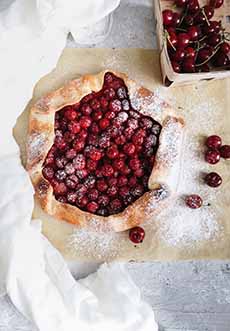
[7] A cherry galette. The fruit or vegetable filling is placed in the center of a circle of dough, which is folded up to create a partial crust (photo © Uliana Kopanytsia | Unsplash).
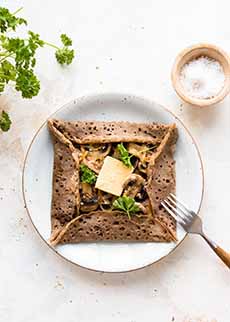
[8] A Galette Bretonne is a buckwheat crêpe with a savory filling. Here it’s sautéed mushrooms, but eggs with ham is another popular choice. Here’s the recipe (photo © Cooking With Elo).
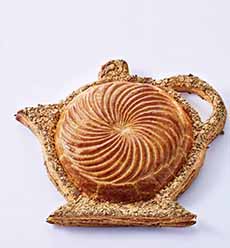
[9] How about a teapot-shape galette (photo © Maison Lenotre).

[10] Or a galette shaped like an almond, after the frangipane inside. The galette below it has a fox etched in the pastry, running across the top (photo © Yann Couvreur Pâtisserie).
|
|
Our Top Pick Of The Week is the first “official” cake of the New Year. Galette des Rois, or Epiphany Cake.
You can probably pick one up from your nearest French bakery, or order online from any number of sites, including The French Confection and Goldbelly.
At Goldberry the Galette des Rois, from Chef Daniel Boulud, is shipped uncooked and frozen and you bake it yourself. How’s that for a “homemade” masterpiece (photo #2)?
A NOTE ABOUT EPIPHANY, THE HOLIDAY FOR WHICH THE GALETTE IS SERVED
Celebrated on January 6th, Epiphany marks the end of the Christmas season (it’s the twelfth day of Christmas) and the beginning of Carnival (which concludes with the beginning Lent). It’s a religious feast day commemorating the arrival of the Magi (the Three Kings, les trois Rois in French) in the Bethlehem manger, bearing gifts for Baby Jesus.
The terminology can get confusing to those not schooled in the tradition.
Epiphany is also known as Three Kings Day, the Day of Kings and Feast Of The Kings (Fête des Rois in French).
Galette des Rois is also called Cake Of The Kings, King Cake, and Epiphany Cake.
In the south of France, the cake is a different recipe and called the Gâteau des Rois (gâteau is French for cake).
The French Galette des Rois, King Cake, is not related to the Mardi Gras King Cake in Louisiana. It may have been the inspiration for the multicolored American King Cake, but only the names are the same. The French cake is made with puff pastry; the Mardi Gras cake is a yeast cake.
The French cake is eaten from Epiphany until the end of January. In New Orleans, the cake is consumed during the entire pre-Lenten season, from Epiphany through Mardi Gras.
You don’t have to be Christian to enjoy the cake; you can buy one or make one and recount the history of the cake as you eat it with friends and family.
To recap: Yes, you can eat Galette de Rois for the entire month of January. It’s a great occasion to invite people over for coffee and cake.
THE HISTORY OF GALETTE DES ROIS
You may read that the tradition of Galette des Rois dates back to the Roman times when festivals were organized to honor the gods. Ahem: Neither Jesus nor the three Wise Men existed then, so the source of a feast to commemorate them is a [big] stretch.
However, it can be said that some Christmas traditions and customs do stem from the pagan Roman festival of Saturnalia, which honored the god Saturn, whose reign was depicted as a Golden Age of abundance and peace [source 1, source 2].
As Christianity became the dominant religion in Rome, it adopted pagan traditions to make Christianity more accessible and appealing to potential converts.
The Origin Of The Galette Des Rois
Some sources say that the French have been serving up Galette des Rois since the 13th or 14th-century [source 1, source 2].
It was initially known as Gâteau des Rois.
Note that a gâteau is a raised cake, whereas a galette is generally flat, crusty and often filled. The style, the terminology, or both may have changed over time.
Purportedly, the dessert was created to honor the three kings who traveled thousands of miles to visit the baby Jesus in Bethlehem.
But, says master French pâtissier Raymond Blanc, OBE (Order of the British Empire), “this story is a load of old baloney!” (Here’s M. Blanc’s recipe for Gateau des Rois [photo #1]).
It was really created in more modern times, says Blanc, the chef patron at Le Manoir aux Quat’ Saisons, a hotel-restaurant in Great Milton, Oxfordshire, England.
The inventor was an enterprising French pâtissier who saw the income opportunity. However, we couldn’t verify either story.
Later, Spanish and French settlers brought the Galette des Rois to America, where it may have inspired the Mardi Gras King Cake [source].
Regardless of the origin story, Galette des Rois has turned into a traditional party dessert. Children eagerly await finding the charm (fève‡‡) hidden in the filling. Whoever gets the slice with it becomes the King or Queen for the day, and everyone else must obey their commands.
SO WHAT EXACTLY IS THE GALETTE DES ROIS?
The galette is a frangipane* pithivier†. The latter is a pie made from two disks of flaky puff pastry (pâte feuilleté) surrounding a filling, sweet or savory†. Galette de Rois is filled witn frangipane, almond cream.
Fève: Each cake comes with a hidden charm or other trinket, called a fève (it was originally a bean, representing baby Jesus)‡‡, baked into it.
A gold paper crown, provided by the baker, sits on top for the initial presentation. The person who gets the slice with the charm becomes “king” or “queen” for the day, and gets to wear the gold paper crown.
The king or queen: It’s an entailed honor: By tradition, the king or queen has to provide next year’s galette‡.
Most people head to the nearest French bakery to buy a Galette des Rois. But you can bake one: Here’s an Epiphany Cake recipe from the two-Michelin-star French chef Héléne Darroze.
The Different Meanings Of “Galette”
Rustic tart: Pastry aficionados may think of a galette as a rustic pie or tart filled with fruit or vegetables (asparagus, mushrooms, or tomatoes, e.g.—photo #7). This galette, often referred to as a fruit galette, was originally made before the existence of pie plates when the crust was folded up and pleated by hand.
Buckwheat crêpe: In Haute-Bretagne (Upper Brittany, France), the Galette Bretonne is a buckwheat crêpe loaded with savory fillings (photo #8).
Galette des Rois from Northern France (photos #1 and #5) is a flat, circular cake, a combination of pâte feuilleté (puff pastry) and frangipane filling.
In fact, the term galette evolved from the Old French galete and gale in the Norman dialect, meaning a kind of flat cake.
Southern Galette des Rois: In the south of France, in Provence, the recipe is different: It’s an orange blossom-flavored, brioche-style cake covered with candied fruit and a sprinkle of pearl sugar (photo #6). This style can also be found in Spain and other Spanish-speaking countries.
Variations:
Today, pâtissiers across France make their own versions of the traditional galette, from Pierre Hermé’s rice pudding and caramel galette to others covered in edible gold dust [source].
Check out the shapes in photos #9 and #10.
There’s also a galette with a shortbread crust instead of puff pastry, popular in Western France [source and a chocolate-pear recipe].
Some pastry chefs switch out the frangipane for apple, caramel, chestnut, pistachio, or raspberry filling [source]. Here’s a recipe for a chocolate-pear and raspberry galette.
Pastry chef Cédric Grolet at the Meurice in Paris topped the crust with a mix of 10 different organic grains and seeds (white, red and black quinoa, pumpkin, sesame and sunflower seeds, almond, kasha, blond and brown linen seeds).
Some depart totally, like the Mille-Feuille des Rois from Pierre Marcolini, who presents a square shape made with cocoa puff pastry, and a filling made with grand cru chocolate and hazelnut praline.
On a more tame note, some chefs like Dominique Costa at the Péninsula in Paris top the puff pastry with crunchy slivers of roasted and caramelized almonds and hazelnuts, with slivers mixed into the frangipane. Oh là là!
And Pierre Hermé, who can be extremely creative, garnishes some of his traditional galettes with simple glazed apple slices (photo #5).
Other versions of the Galette des Rois are made in Belgium, Germany, Portugal, and Switzerland.
GALETTE, PIE, & TART: THE DIFFERENCE
Pies are baked in a sloped pie pan, either open face or with a top crust. Both variations have crimped edges. flaky shortcrust pastry
Galettes are free-form (i.e., formed by hand), and baked on a baking sheet. The edges of a fruit galette are folded up over the filling, leaving a wide opening of filling at the center.
Galette de Rois from northern France, however, takes the form of a large, flat, round, filled, pastry, not what we think of as a conventional pie.
Tarts are baked in a special pan, usually fluted with a removable bottom so they can easily be unmolded before serving.
The pastry is stiff pâte sucrée pastry that enables the tart to “stand up straight” without any assistance.
Here’s more on the differences between cakes, gateaux, tortes, tortas, and tarts.
Note that relatively recently, the terms pie and cake were used interchangeably. A prominent example is Boston Cream Pie, which is a layer cake.
> The different types of pastry.
> The different types of pies and pastries: a photo glossary.
> The history of Galette Des Rois.
________________
*What is frangipane? Frangipane is a dense pastry cream flavored with almond paste. The almond paste base is enriched with sugar, butter and eggs. (Alternatively, milk, sugar, flour, eggs and butter are mixed with ground almonds). It is related to marzipan, which also has a base of almond paste. A key difference is that frangipane is a spreadable cream, and marzipan is a semi-hard almond candy.
†A pithivier is a round, enclosed pie made from two disks of puff pastry, with a filling stuffed in between. The top has the appearance of a hump and is traditionally decorated with spiral lines drawn from the top outwards with the point of a knife, plus scalloping on the edge. It is named after the French town of Pithiviers, assumed to be the origin. The pie is traditionally finished with an egg wash shine to the top of the crust, or by caramelizing a dusting of confectioner’s sugar at the end of baking, or both. The filling of the pithivier is often frangipane (sometimes combined with fruit such as cherry or plum), but savory pies with vegetable, meat or cheese filling can also be called pithivier [source].
|









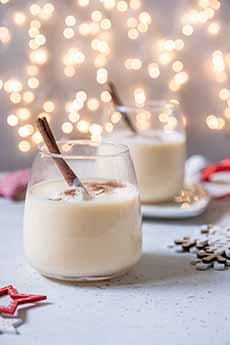
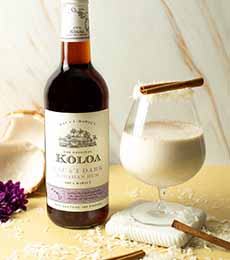
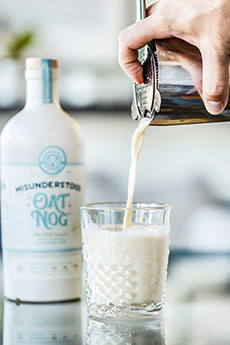

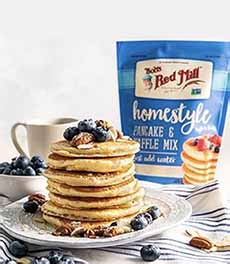
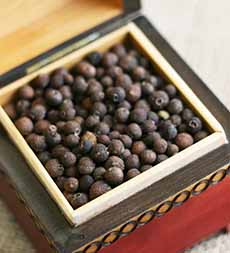
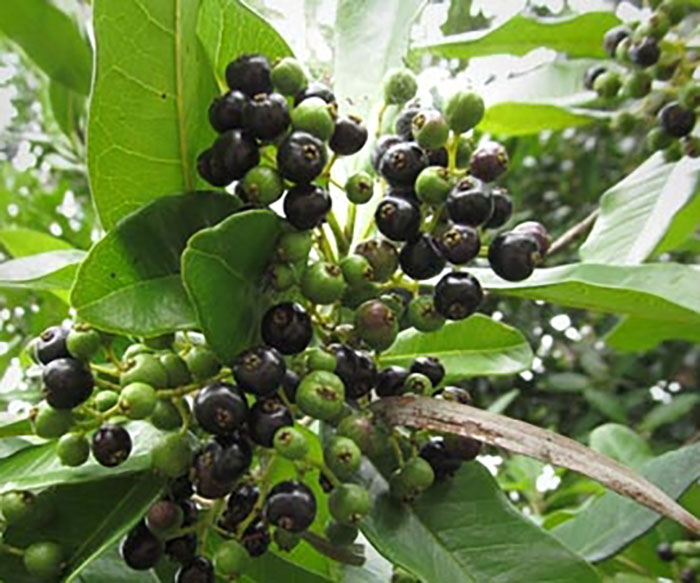
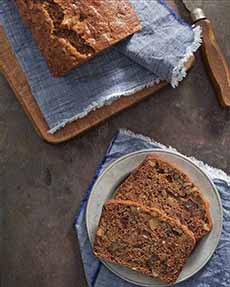
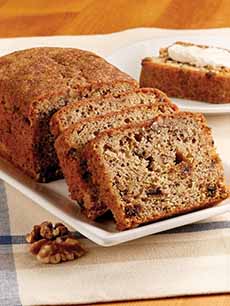
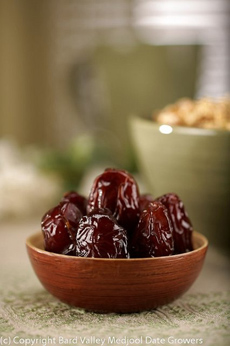 [3] Chop succulent dates for the batter (photo ©
[3] Chop succulent dates for the batter (photo © 